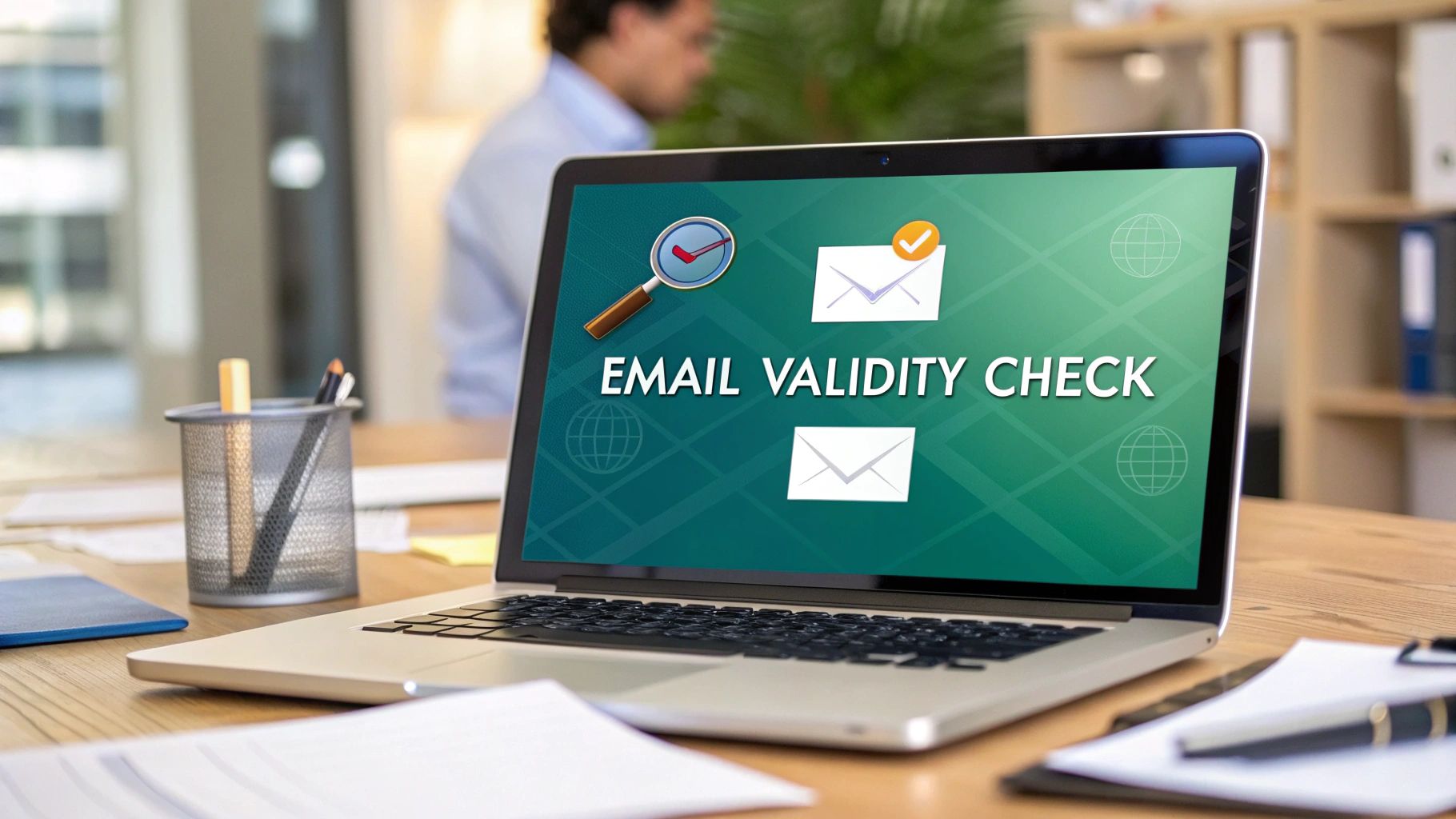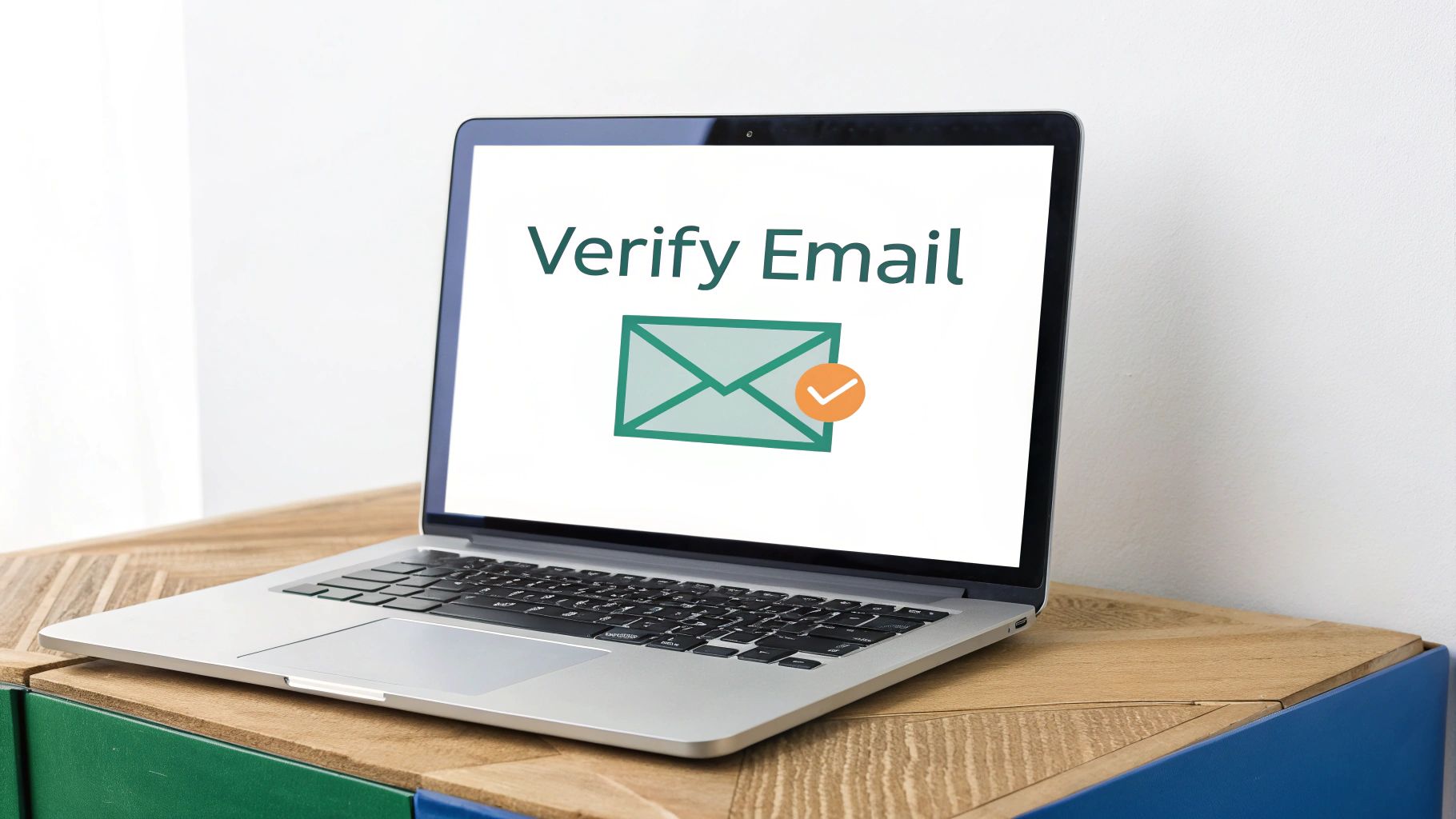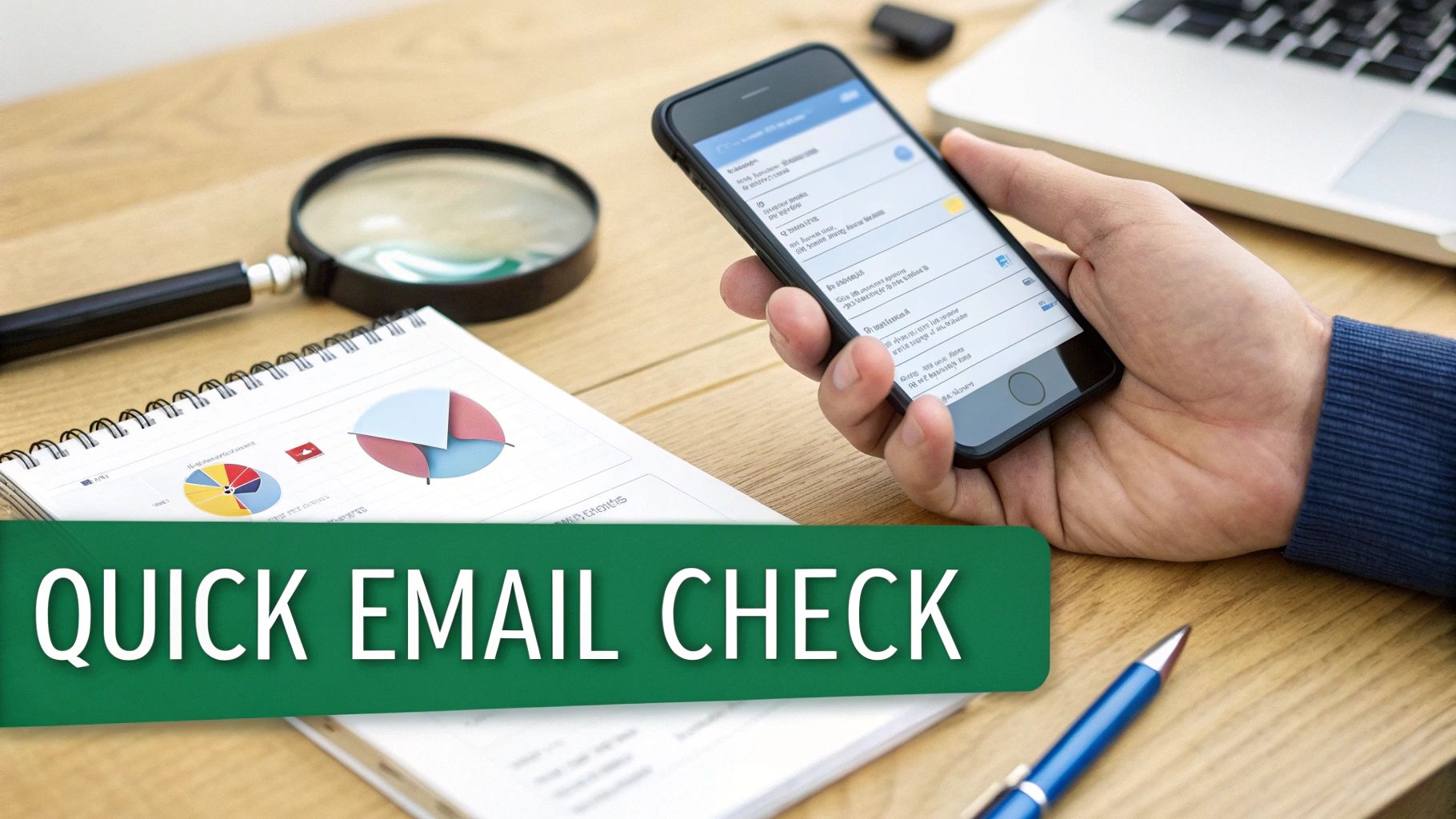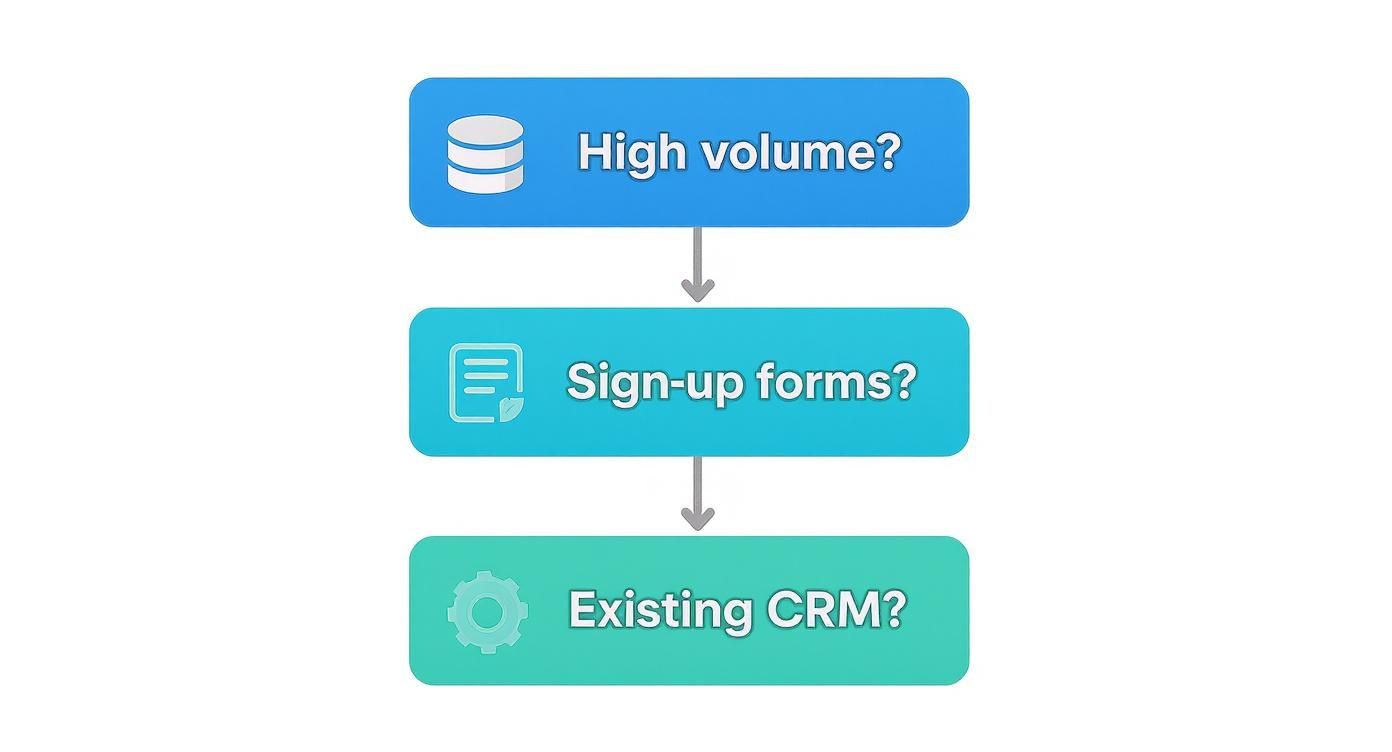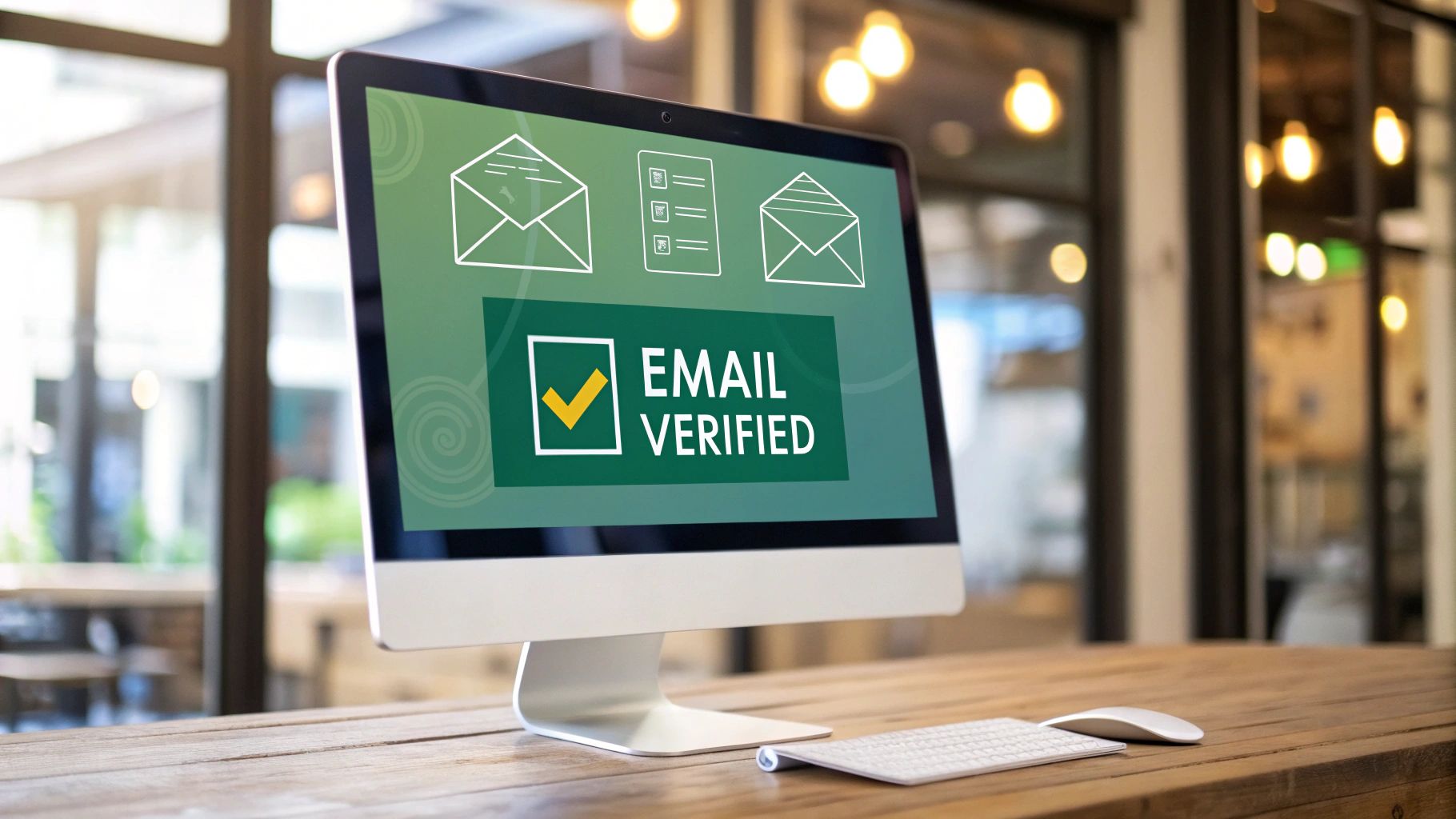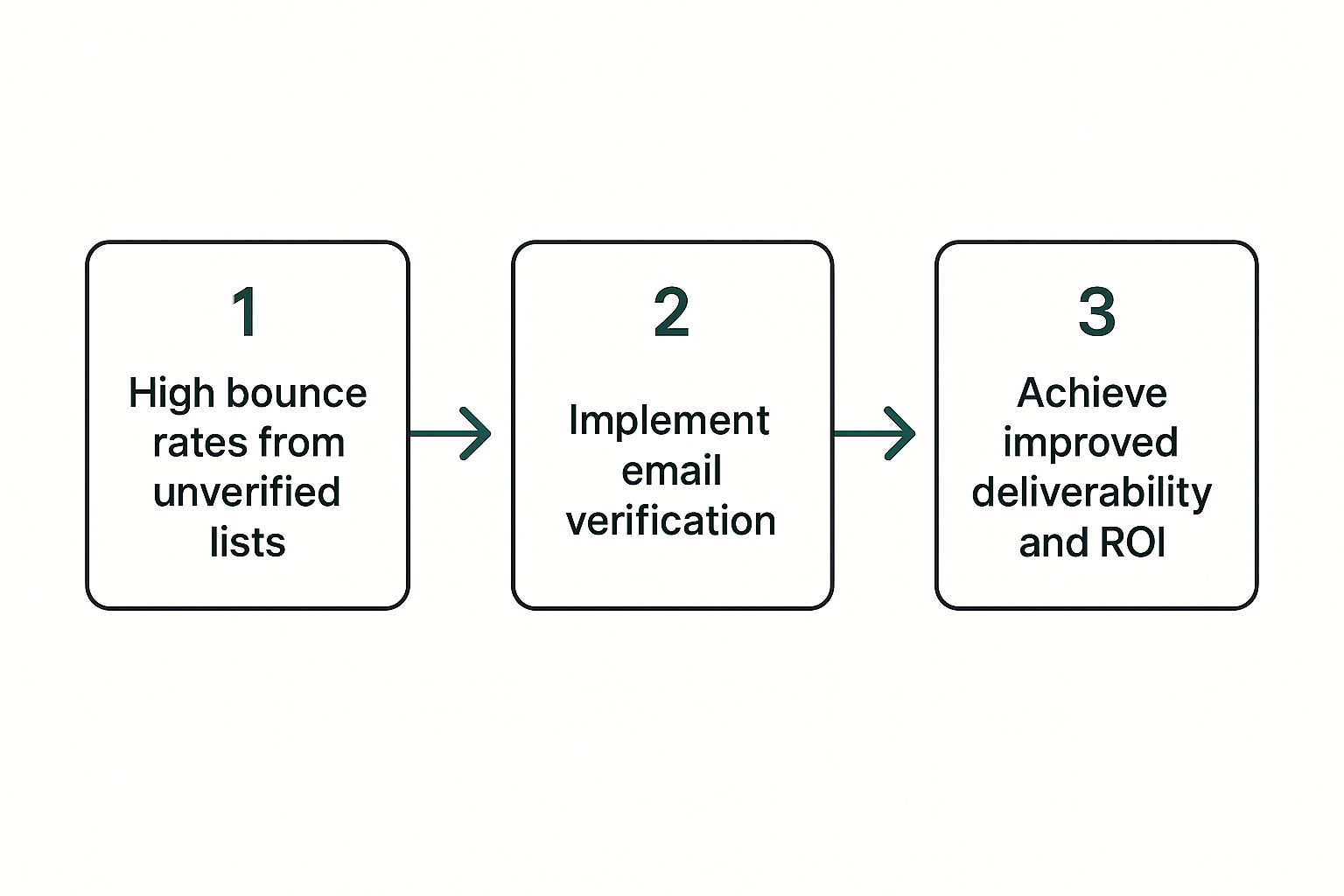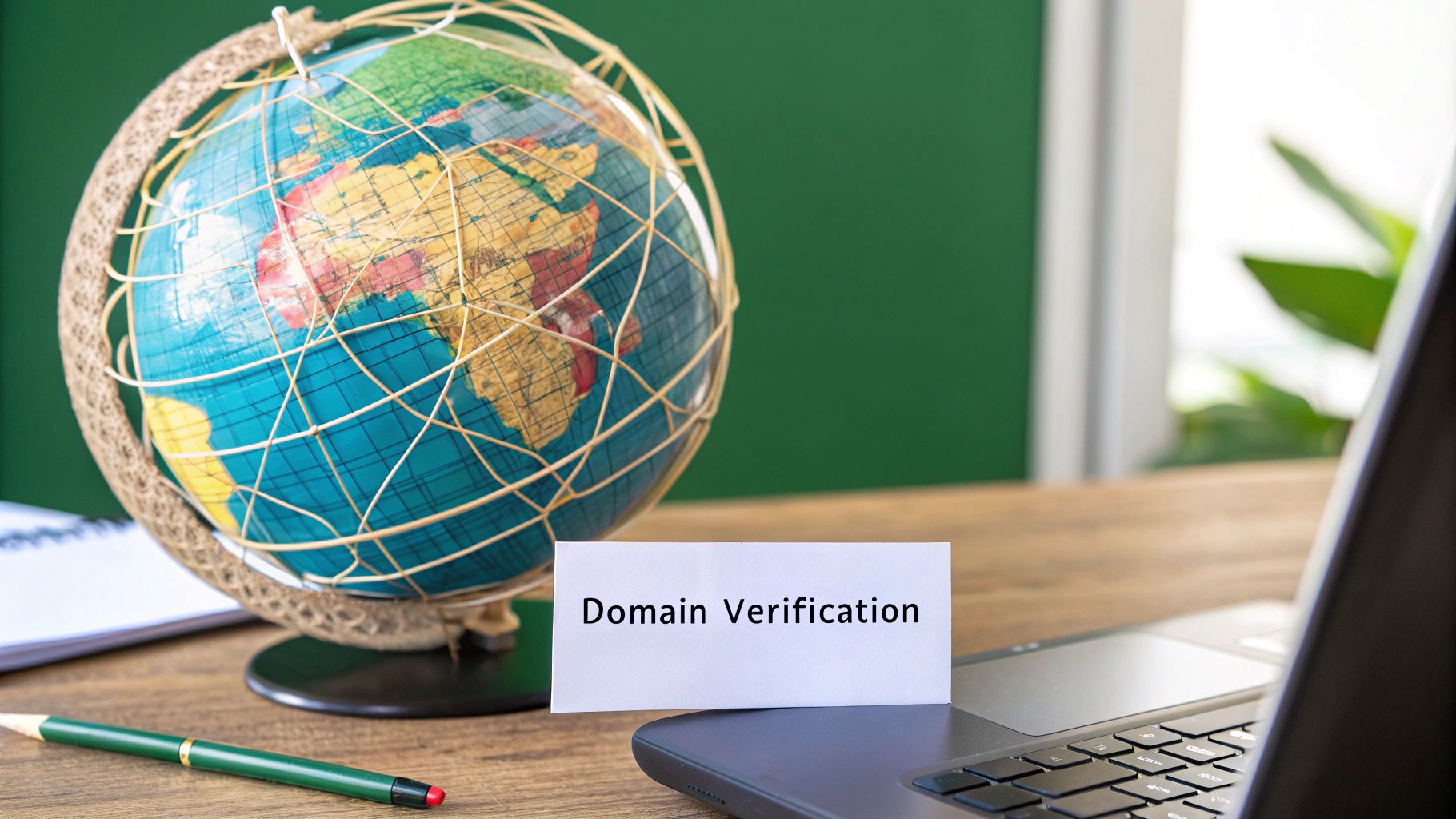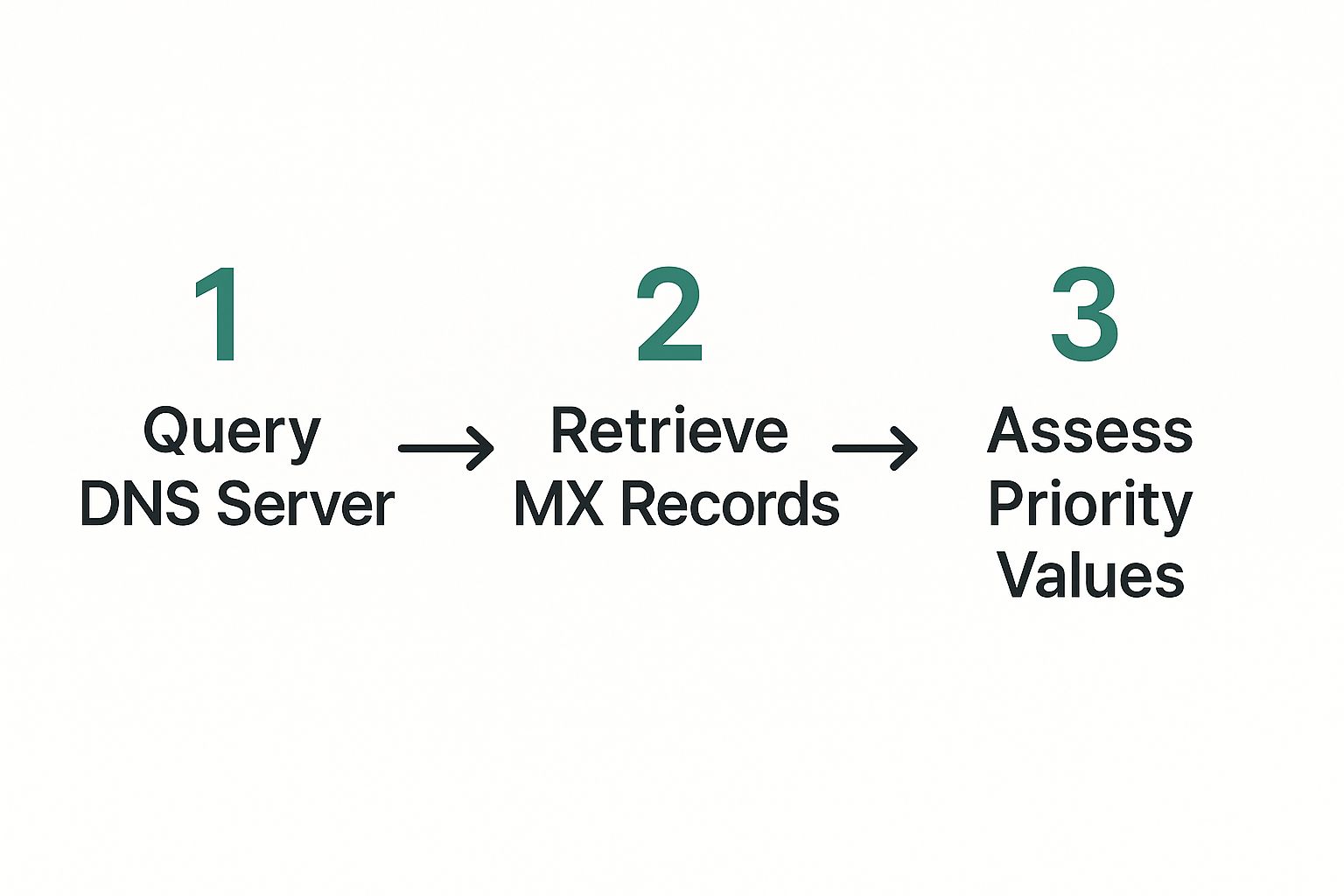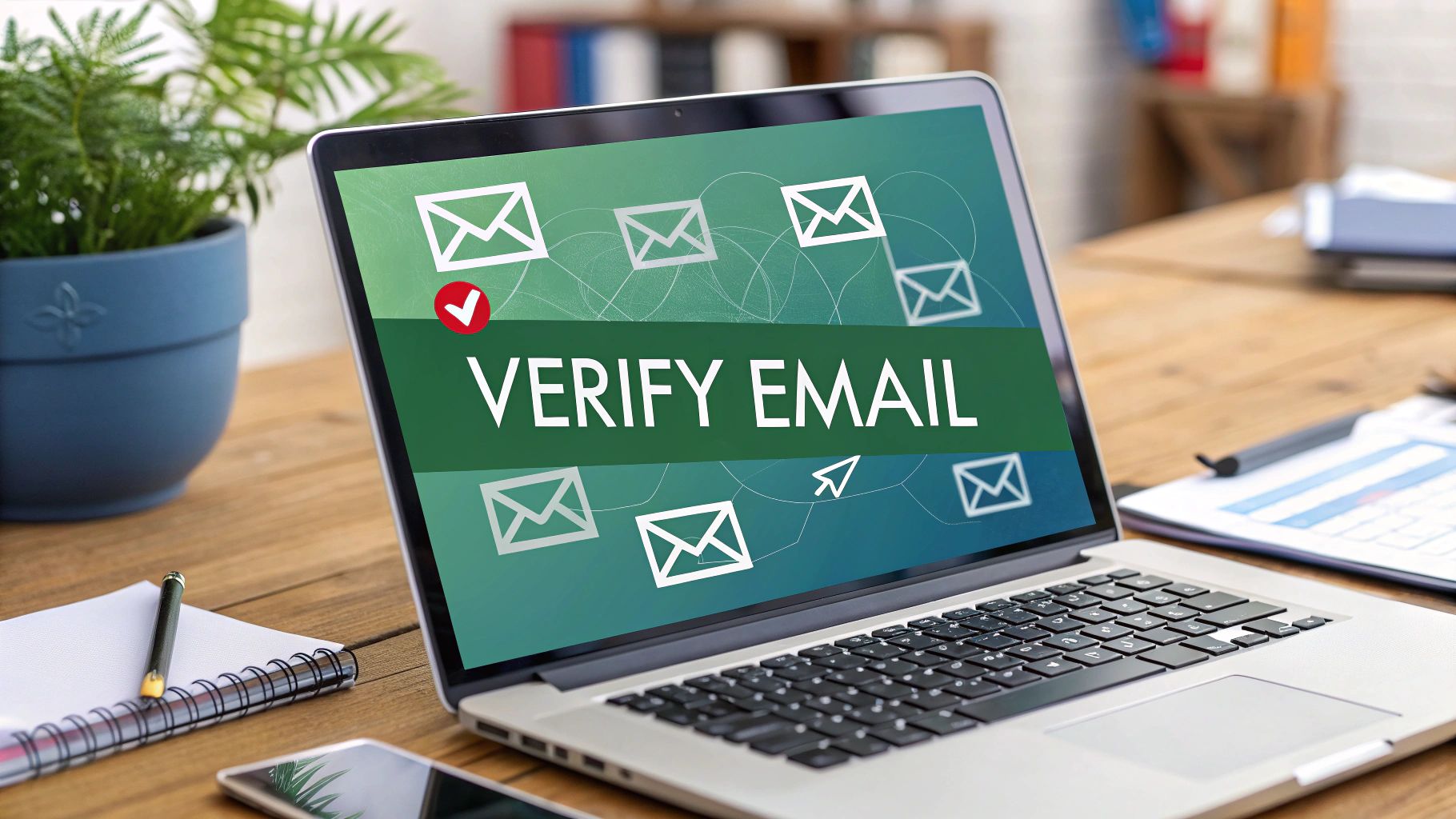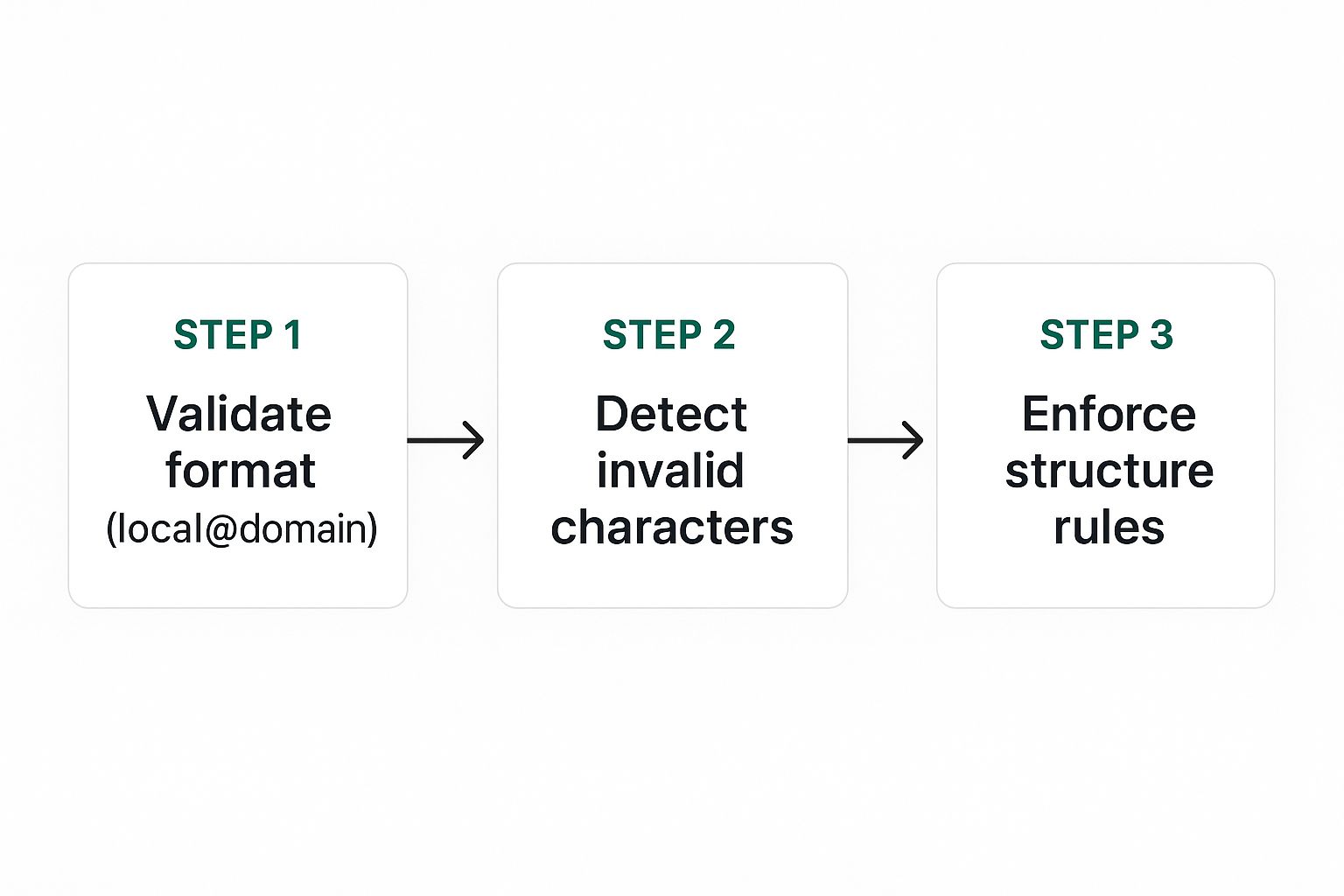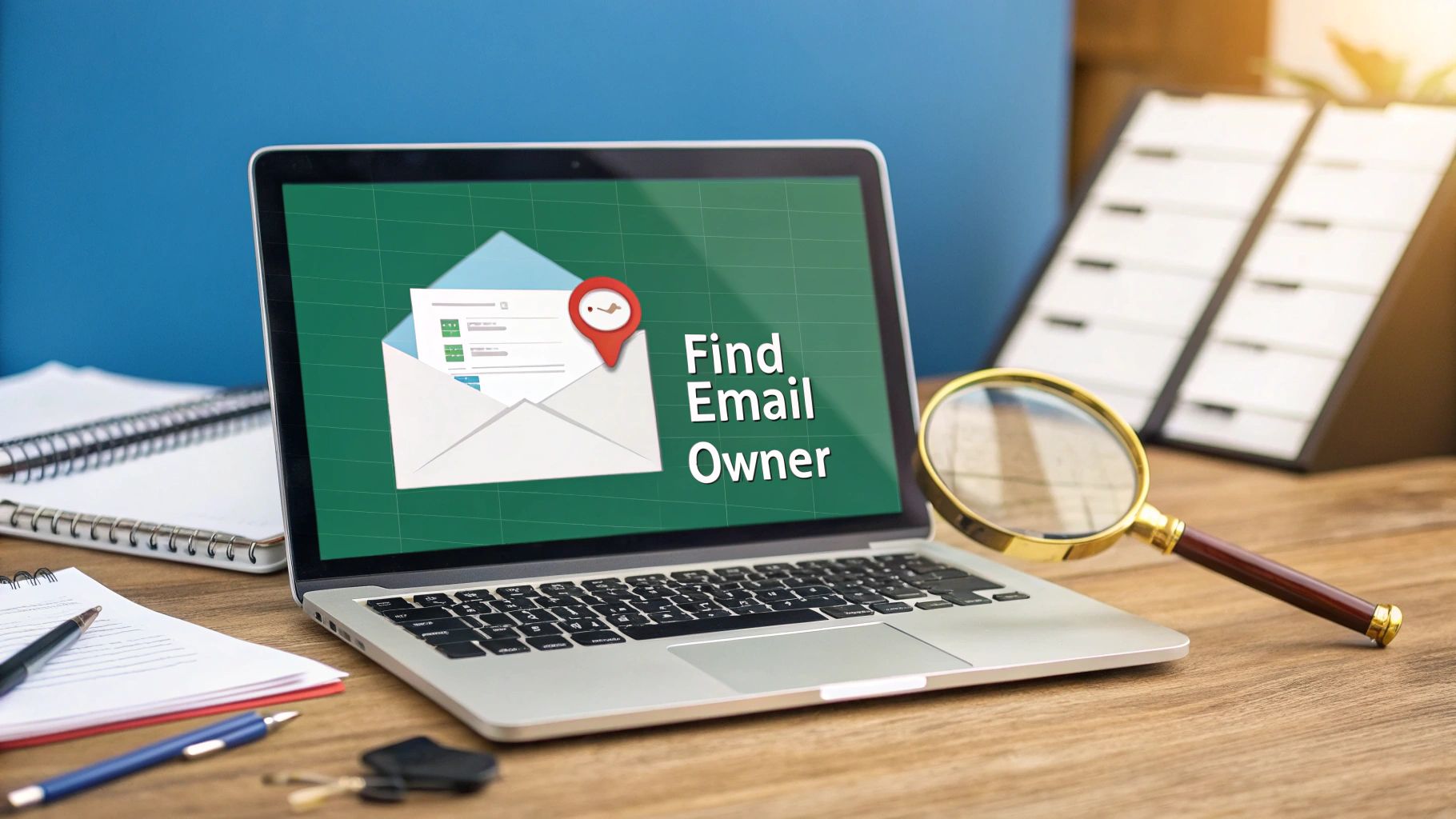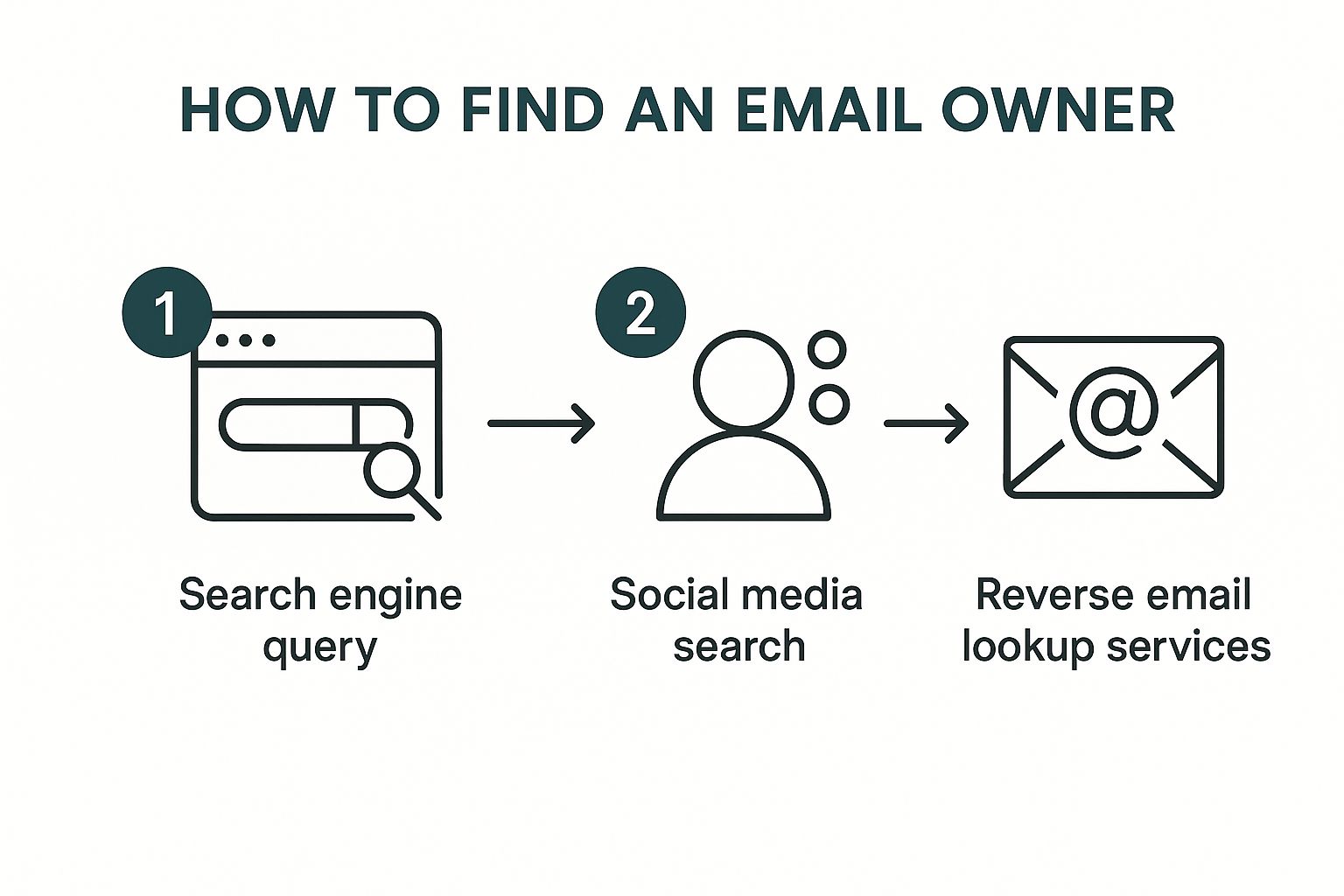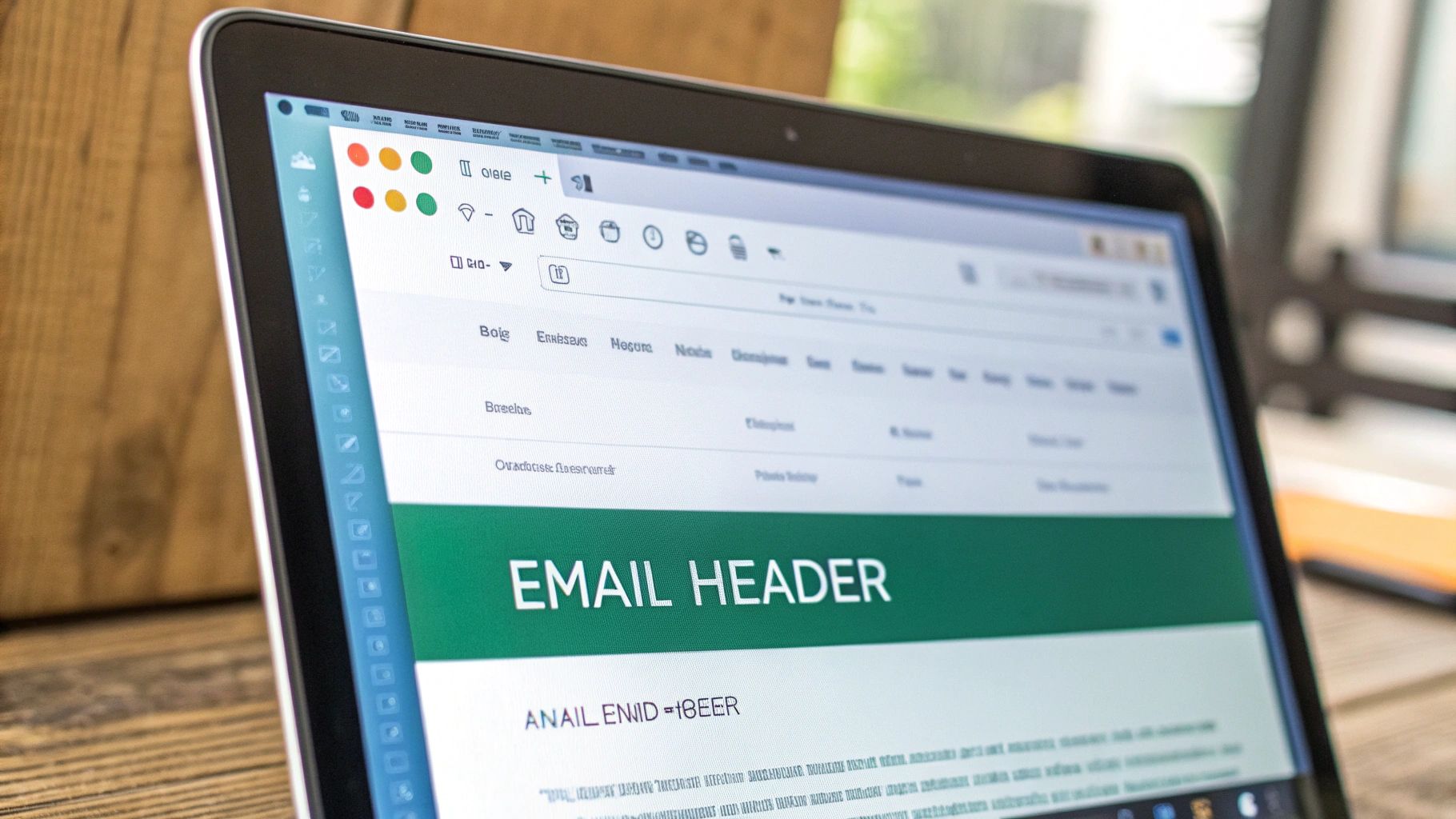Think of an email validity checker as a bouncer for your contact list. It's a simple tool that checks if an email address is real and can actually receive messages, stopping all the invalid, fake, or dead-end addresses before you ever hit send. This one step is crucial for keeping your sender reputation safe and getting the most out of your marketing budget.
Why a Clean Email List Is Your Greatest Asset
Your email list is the foundation of your entire digital marketing strategy. A solid, clean list can support every campaign you build, making sure your messages land where they're supposed to. But if that foundation is full of cracks and bad addresses, the whole thing gets wobbly.
An email validity checker isn't just a nice-to-have tool; it's the guardian of your most valuable digital asset.
Sending emails to a "dirty" list is like driving on a road riddled with potholes. Your carefully written messages bounce back, get lost, or just never show up. Every single bounce is a bad signal to Internet Service Providers (ISPs) like Gmail and Outlook, slowly chipping away at your sender reputation. A bad reputation means even your legitimate emails are more likely to end up in the spam folder, invisible to real, interested customers.
The Hidden Costs of a Neglected List
Letting your list hygiene slide comes with some very real costs that go way beyond a few undelivered emails. The fallout can seriously stunt your business's growth.
- Damaged Sender Reputation: High bounce rates are a massive red flag for ISPs. Keep it up, and you could get your domain blacklisted, making it nearly impossible to reach anyone's inbox.
- Wasted Marketing Spend: Every email sent to a bad address is money down the drain. This includes what you pay your email service provider and the time you spent creating the campaign.
- Inaccurate Campaign Data: When a huge chunk of your list is invalid, your metrics—like open and click-through rates—are totally skewed. This makes it impossible to know what’s actually working.
- Missed Revenue Opportunities: At the end of the day, a dirty list means you aren't connecting with potential customers. That's a direct hit to your bottom line.
A clean email list is the cornerstone of effective communication. Proactive validation isn't a technical chore; it's a fundamental strategy for ensuring your message is heard, building trust with your audience, and driving sustainable business growth.
The market is catching on. The global demand for these tools is booming, valued at USD 1.1 billion and expected to jump to USD 2.5 billion by 2032. This explosive growth, as noted on openpr.com, shows that smart businesses understand a clean list is non-negotiable.
Of course, you can't clean a list you don't have. If you're just getting started, our guide on how to build an email list is the perfect place to begin. Using an email validity checker from day one ensures you build a healthy, high-quality foundation right from the start.
How an Email Validity Checker Actually Works
Ever wonder what goes on behind the scenes when you verify an email? It’s not magic, but a super-fast, multi-step process that feels like it. Think of an email validity checker as a digital bouncer for your contact list, running a series of quick, logical tests to see if an email address is real, active, and safe to engage with.
Each check builds on the last, starting simple and getting progressively more complex. This layered approach is incredibly efficient at weeding out bad addresses at every stage. Let’s pull back the curtain and see how this digital detective work gets done.
This flow chart gives a great visual of how a messy, ineffective list gets transformed into a clean, high-performing asset.
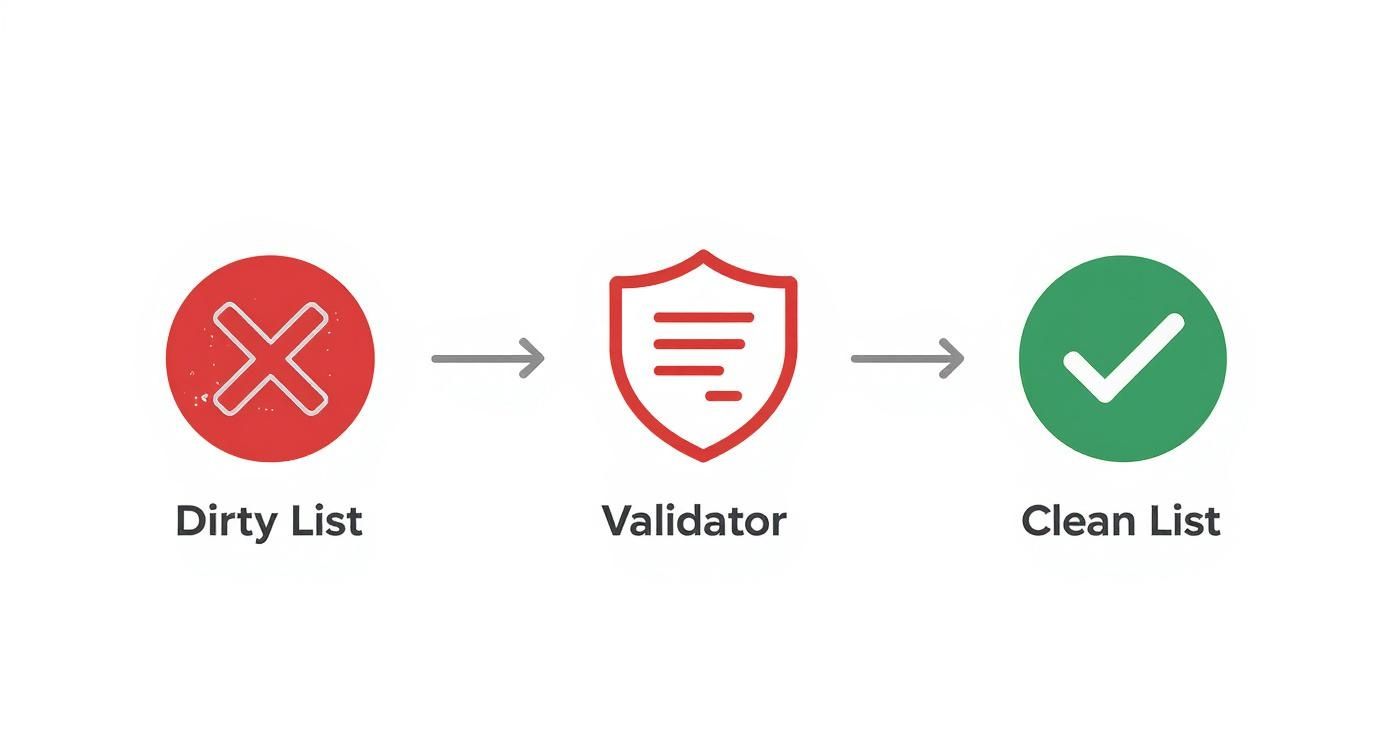
As you can see, the checker is a crucial filter. It systematically kicks out the bad contacts, leaving you with a list you can count on.
The Four Core Layers of Email Validation
An email validity checker doesn’t just perform a single test; it runs a sequence of checks to determine if an address is deliverable. Each layer digs a little deeper, filtering out different types of invalid emails along the way. Think of it as a four-stage security checkpoint.
Here’s a breakdown of what happens in those few seconds:
| Validation Layer | What It Checks | Analogy |
|---|---|---|
| Syntax & Formatting | Checks for the correct structure (e.g., name@domain.com). |
Like a spell-checker, it catches obvious typos and formatting mistakes. |
| Domain & DNS Check | Confirms the domain (@domain.com) exists and is set up to receive email. |
Checking to see if the recipient's city exists on a map and has a post office. |
| SMTP Handshake | Pings the mail server to see if the specific user mailbox exists. | Knocking on the door to see if someone's home, without actually delivering the package. |
| Final Analysis | Identifies risky addresses like spam traps, disposable emails, and role accounts. | The final security sweep that flags suspicious characters before letting them through. |
By combining these four layers, the checker can give you a highly reliable verdict on each email, protecting your sender reputation and boosting your campaign performance.
Step 1: The Syntax and Format Check
The first and most basic test is the syntax check. This is purely a structural review, like a grammar check for the email address itself. It confirms the address follows the universal format rules: a local part, the "@" symbol, and a domain. It's the first line of defense.
For instance, an address like "johndoe@email.com" sails right through. But an entry like "johndoe-email.com" (no "@" symbol) or "john doe@email.com" (contains a space) gets flagged immediately. This simple screen catches all the obvious typos and formatting goofs right off the bat.
Step 2: The Domain Verification
Once an email has the right format, the next step is to check its domain—the part that comes after the "@". The tool looks up the domain (like gmail.com or yourcompany.com) to confirm a couple of critical things.
First, does the domain even exist? And second, is it actually configured to receive email? This prevents you from sending a message to a domain that’s fake, expired, or just not set up for email. It's a fundamental check that stops bounces caused by non-existent destinations.
Think of it this way: domain verification confirms the destination city for your email actually exists on the map. It tells you there's a valid postal service operating there before you even bother looking for a specific street address.
This step alone filters out a huge number of bad addresses, especially those with misspelled or defunct company domains.
Step 3: The SMTP Handshake
Now for the most decisive test: the SMTP handshake. SMTP (Simple Mail Transfer Protocol) is the universal language mail servers use to talk to each other. This check is the digital equivalent of walking up to the recipient's front door and asking if they live there—all without actually ringing the doorbell.
Here’s how it works in simple terms:
- The checker finds the mail server for the domain (e.g.,
gmail.com). - It starts a conversation, basically saying, "Hey, I've got a delivery for
johndoe@gmail.com." - If the mailbox for "johndoe" exists, the server replies, "Got it, I'm ready." The checker then politely cuts the connection without sending anything.
- If the mailbox doesn't exist, the server will immediately say something like, "Sorry, no one by that name here."
This "handshake" confirms the specific mailbox exists with an extremely high degree of accuracy. And since no email is ever sent, it’s a completely safe and non-intrusive way to verify an address.
By combining these layers, an email validity checker provides a clear and confident verdict, giving you the power to keep your lists clean, effective, and primed for high deliverability.
The Real Business Impact of Email Validation
Sure, understanding the nuts and bolts of an email validity checker is interesting, but what does it actually do for your business? The real magic happens when you connect that technical process to tangible, bottom-line results.
Using an email validator isn't just about tidying up a list. Think of it as a direct investment in your company's financial health, brand reputation, and overall agility. These three areas build on each other, creating a powerful flywheel effect that fuels real, sustainable growth.
Let's break down how this simple act of digital hygiene translates into a serious return on your investment.
Financial ROI: Protecting Your Bottom Line
Every dollar you spend on marketing has to pull its weight. Sending campaigns to invalid or non-existent email addresses is the digital equivalent of setting a pile of cash on fire. An email validity checker plugs that hole in your budget, ensuring every cent is spent trying to reach a real person.
Think about it this way: most email service providers charge based on your list size or send volume. If your list is bloated with 15-20% bad addresses, you're literally paying to send messages into a void.
A clean email list guarantees your marketing budget is spent reaching actual, potential customers. By ditching the undeliverable addresses, you cut direct costs and boost the conversion potential of every single campaign.
This isn't just about saving money; it's about making your sales funnel healthier and more predictable. When you improve email deliverability and avoid spam, you give your campaigns the best possible chance to drive revenue.
Reputational ROI: Guarding Your Sender Score
Your sender score is basically your credit score with Internet Service Providers (ISPs) like Gmail, Outlook, and Yahoo. It’s the key metric they use to decide if your emails belong in the inbox or the spam folder. And nothing tanks that score faster than a high bounce rate.
Every time an email "bounces" from an invalid address, it sends a red flag to the ISP. A lot of bounces makes you look like a spammer who bought a shady, low-quality list. Before you know it, they'll start sending all your emails—even to your most engaged subscribers—straight to spam.
This kind of damage can be tough to undo, effectively cutting you off from your audience. An email validity checker is your first line of defense, protecting your sender score by making sure your sends are clean and professional.
Operational ROI: Sharpening Your Strategy
Beyond money and reputation, a clean email list makes your whole operation smarter. When your campaign data is reliable, your team can finally make decisions with confidence. A list full of bad emails completely skews your metrics.
Let's say you see a disappointing 10% open rate. Your first thought might be that your subject line was a dud. But what if 20% of your list was undeliverable from the start? Your actual open rate among real recipients was much higher, and that subject line might have been a winner.
Bad data leads to bad decisions. Here’s how a clean list sharpens your operations:
- Accurate Performance Metrics: Get a true read on what resonates with your audience with reliable open, click, and conversion rates.
- Sharper Segmentation: Build targeted and effective audience segments without wasting effort on contacts who will never see your message.
- Increased Efficiency: Free up your marketing team to focus on creating great content instead of constantly troubleshooting deliverability fires.
Ultimately, knowing how to verify an email is a foundational skill. It pays dividends across your entire business, ensuring all your hard work is built on a solid foundation of clean, reliable data.
Going Beyond Basic Email Verification
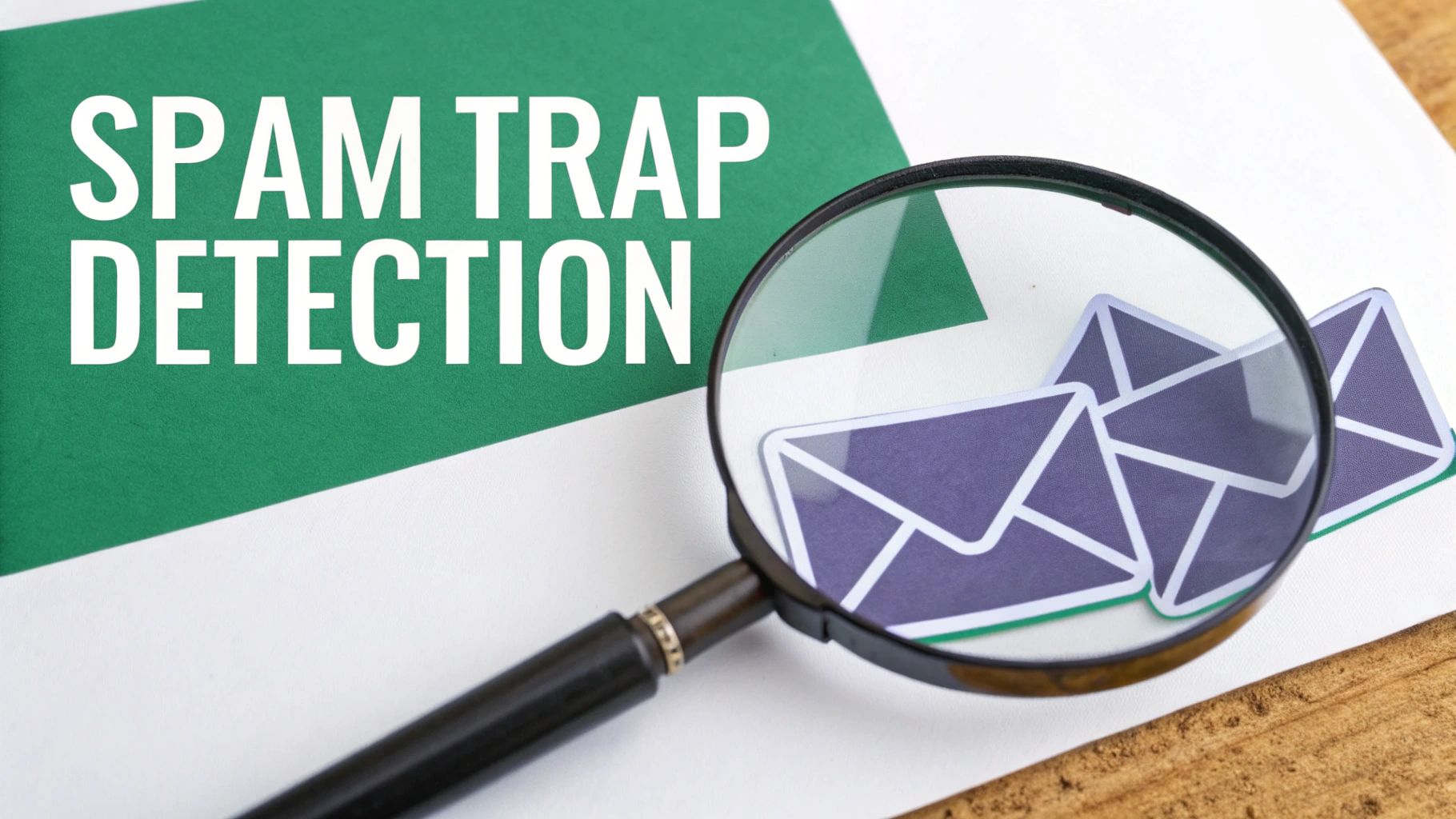
It’s easy to think all email validation tools are the same, but that’s far from the truth. While a basic check might tell you if an email address technically exists, a modern email validity checker does so much more. It digs deeper, moving past a simple "yes" or "no" to gauge the real quality and risk of every contact you have.
This kind of advanced analysis is critical. Why? Because some emails that pass a basic check can still be incredibly toxic to your sender reputation. Think of it like this: a simple check confirms someone’s name and address exist. An advanced check is more like a background check—it reveals their history and flags potential problems you’d want to know about before reaching out.
Uncovering Hidden Dangers with Spam Trap Detection
One of the biggest threats lurking in your email list is the spam trap. These aren't regular inboxes. They're special email addresses set up by Internet Service Providers (ISPs) and anti-spam groups specifically to catch senders with sloppy list-building habits.
Sending an email to a spam trap is like tripping a silent alarm. It sends an immediate signal to mailbox providers that you could be a spammer, and the consequences are severe. Your domain can get blacklisted, and your deliverability can tank almost overnight. An advanced validation tool is trained to spot the digital fingerprints of these traps, yanking them from your list before they can do any real damage.
Identifying Risky Catch-all Servers
Next up are catch-all servers. These are configured to accept emails for any address at a certain domain, even addresses that don't actually exist. At first, that might not sound so bad since your email won't bounce. But it creates a huge headache for marketers.
The problem is you have no idea if your message landed in front of a real person or just vanished into a digital black hole. Sending to a bunch of unverified catch-all addresses kills your engagement rates, which is another major red flag for ISPs. A good email validity checker can identify these servers and mark the associated emails as "risky," letting you decide if they're worth keeping.
An advanced email checker provides a more nuanced view of your list's health. It doesn't just tell you which emails are deliverable; it tells you which ones are valuable, helping you focus your efforts on genuine, engaged prospects.
This screenshot from EmailScout's website shows you exactly what these nuanced results look like. It's not just a simple valid/invalid status.

The dashboard clearly breaks down emails into categories like "Valid," "Risky," and "Invalid." This gives you actionable intelligence, not just raw data.
Weeding Out Disposable Email Addresses
Disposable emails are exactly what they sound like: temporary, self-destructing inboxes. People use them to grab a freebie or sign up for a newsletter without handing over their real email address. For your business, these contacts have zero long-term value.
While they might work for a few hours or days, they quickly become inactive and start causing bounces. Even worse, a list full of disposable addresses signals to ISPs that your lead generation quality is low, which can hurt your sender reputation over time. The best tools maintain massive, constantly updated lists of disposable email providers to make sure these temporary contacts get filtered out.
Ultimately, going beyond a basic check is about understanding the difference between deliverability and quality. The right tool gives you a full risk assessment for every contact, helping you build a list that’s not just clean but genuinely valuable for growing your business.
How AI Is Taking Email Validation to the Next Level
Traditional email validation methods are solid, but they’re a bit one-dimensional. They work off a simple, rule-based system that answers one basic question: “Can this email address receive a message?” It’s a useful check, for sure, but it has its limits.
The next leap forward is powered by Artificial Intelligence, which asks a much smarter question: "Is this email address not only deliverable but actually worth sending to?"
AI models go way beyond the static checks of the past. Instead of just confirming an address format or pinging a server, they learn from massive datasets filled with billions of real-world email interactions. This lets them spot the subtle patterns and behaviors that signal the true quality and lifespan of an email address.
Think of it this way: a standard email validity checker is like a bouncer checking IDs at a door. They confirm the ID is real and belongs to the person. An AI-powered checker, on the other hand, is more like an experienced event host. It doesn't just check the ID—it also gets a feel for the guest and predicts whether they'll be a great addition to the party.
Predictive Accuracy and Deeper Insights
This predictive power is where AI really shines. By analyzing historical data, AI can get ahead of "email decay"—that natural process where emails become invalid as people switch jobs or ditch old accounts. It can flag an address that, while technically valid today, shows all the signs of bouncing in the next few months.
This forward-looking analysis gives you a much deeper level of insight. Instead of a simple valid or invalid stamp, an AI-powered email validity checker can assign a quality score, helping you focus on your most promising contacts.
AI isn't just a buzzword here; it's a practical tool that delivers smarter, faster, and more predictive results. It turns list cleaning from a reactive chore into a proactive strategy for keeping your email performance at its peak.
This shift is a big deal for any business relying on email marketing. By using AI, verification services can analyze user behavior and historical data to predict if an email will stay active long-term. They incorporate pattern recognition to optimize lists in real time, moving far beyond what older methods could do.
Key AI-Powered Enhancements
Bringing AI into email validation delivers some specific, game-changing advantages over the old way of doing things. It creates a much more robust and intelligent filter for your lists.
- Smarter Ambiguity Resolution: AI is brilliant at sorting out ambiguous addresses, like those on "catch-all" servers. It looks at past engagement data for that domain to predict how likely it is a real person will see your message, giving you a more nuanced "risky" or "safe" rating.
- Behavioral Pattern Recognition: AI models can identify email addresses tied to sketchy behavior, like frequent unsubscribes or super low engagement across different networks. This protects your sender reputation from contacts who are technically valid but toxic in practice.
- Automated List Optimization: With its predictive muscle, AI can suggest which "risky" emails are worth keeping based on their engagement potential and which ones you should drop to prevent future bounces.
To get a sense of the broader impact of artificial intelligence on business, it's worth reading up on innovative AI models like Gemini 2.0. By integrating these advanced capabilities, an email validity checker becomes more than a simple cleaning tool—it becomes an intelligent guardian of your email marketing ROI.
Weaving Email Validation Into Your Daily Workflow
An email validity checker is a game-changer, but only if you use it consistently. Think of it less like a special tool you pull out once a year and more like a core part of your daily operations. The real magic happens when you move from simply knowing about validation to actually embedding it into your workflow.
When list hygiene becomes an automatic, ongoing process, you stop playing catch-up. Instead of reacting to bad data after it's already caused problems, you prevent it from piling up in the first place. This keeps your sender reputation protected around the clock and ensures you're always ready for your next campaign.
The goal is simple: make clean data your default setting.

Building a Proactive Validation Strategy
A solid strategy isn't just about cleaning the data you have; it's also about stopping bad data from ever getting in. It’s a one-two punch of proactive cleanup and preventative defense.
1. Start with a Bulk Cleanup
Before you even think about your next big campaign, run your entire existing email list through a bulk validation service. This gives you a clean slate. You'll immediately scrub years of accumulated typos, dead addresses, and other digital gunk. It's the single fastest way to boost your deliverability and get a clear picture of your list's true health.
2. Turn On Real-Time Verification
This is your front-line defense. The most effective way to keep your list pristine is to integrate a real-time validation API at every single point where someone can give you an email. We’re talking about:
- Newsletter sign-up forms
- "Contact Us" pages
- Webinar registrations
- Checkout pages
This acts like a digital bouncer, instantly rejecting typos and fake emails before they can even set foot in your database.
3. Schedule Routine Checkups
Email lists aren't static. They decay over time as people switch jobs, change providers, or just abandon old accounts. To fight this natural erosion, get into the habit of cleaning your entire list every quarter. This scheduled maintenance catches any addresses that have gone bad since your last check, keeping your database fresh and potent.
Email validation isn’t a one-time fix. It’s continuous data hygiene. By making it a routine part of your workflow, you build a resilient, high-performing marketing asset that consistently delivers results.
How to Handle Different Verification Results
A modern email validity checker doesn't just give you a simple "good" or "bad." The results are more nuanced, and knowing how to act on them is key to getting the most out of your list.
What about contacts flagged as "risky" or "unknown"? Don't just delete them. A smart move is to create a separate segment for these addresses. Send them a low-stakes re-engagement campaign to test the waters without putting your main sender score on the line.
If they open, click, or reply, great! You can move them back to your main list. If they bounce, you know it's time to remove them for good.
To explore the different options out there, our guide on the best free email verification tools is a fantastic place to start your search. By pairing automated checks with intelligent segmentation, you create a powerful, self-sustaining system for keeping your email list in top shape.
Common Questions About Email Validity Checkers
Diving into email validation for the first time usually sparks a few questions. It's a non-negotiable part of modern marketing, but there are some common myths that can trip people up. Let's get you some clear, straightforward answers so you can make smarter moves with your email strategy.
We’ll clear up some of the most frequent questions people have about using an email validity checker. This should help you understand its role, its limits, and how to get the most out of it.
How Often Should I Validate My Email List?
This is easily one of the most common questions, and the answer really depends on how you're growing your list. If you have sign-up forms that are constantly bringing in new leads, real-time validation is a must. Using an API to check emails the moment they're submitted stops bad data from ever poisoning your database.
For the lists you already have, a full-on bulk cleaning every 3 to 6 months is a solid rule of thumb. Email addresses go bad all the time—people switch jobs, ditch old accounts—and this kind of routine maintenance keeps your list in top shape.
Always, always run a full bulk validation before you kick off a major marketing or sales campaign. Think of it as a final check-up. This one step will do wonders for your deliverability and protect your sender score when it counts the most, ensuring you get a much better return on your efforts.
Can an Email Checker Guarantee 100 Percent Deliverability?
Nope, and you should be wary of any tool that promises it can. No service can guarantee 100% deliverability. What an email validity checker does is tackle the single biggest reason for poor deliverability: sending emails to addresses that don't exist. By getting rid of hard bounces, it gives you the strongest possible foundation to build on.
But other things are at play when it comes to landing in the inbox. These include:
- Your email content: Using spammy words or cramming your email with links can get you flagged by filters.
- Sender history: Your domain's reputation, which you build over time, is a huge factor.
- Recipient engagement: If people aren't opening or clicking your emails, ISPs take that as a sign that your content isn't wanted.
A quality email validity checker is your best weapon for improving deliverability, but it’s just one part of a bigger email marketing puzzle.
What Is the Difference Between Single and Bulk Verification?
The main difference here is all about timing and scale. Both are vital for keeping your lists clean, but they're used for different jobs.
Single email verification checks one address at a time, almost instantly. You'll typically see this used with an API on your website's sign-up forms. This is your first line of defense, stopping bad emails right at the door.
Bulk email verification, on the other hand, lets you upload an entire list—whether it's a few hundred or a few million emails—and clean them all at once. This is your go-to for maintenance. It's perfect for scrubbing your existing databases or prepping a big list for a new campaign. The best workflows use both to keep their data spotless.
Ready to see what a difference a clean list makes? EmailScout provides powerful, real-time email verification to shield your sender reputation and drive up your campaign ROI. Discover how our tools can scrub your lists and deliver better results. Get started with EmailScout.
